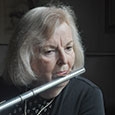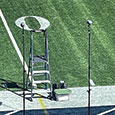This past November I attended a violin studio recital at Lawrence University in Appleton, Wisconsin. The program featured the complete volume of Jakob Dont’s (1815-1888) 24 Etudes and Caprices, Op. 35. Each member of the violin studio performed one or two of the etudes from the collection. The printed program for the 75-minute recital not only listed the name or tempo marking for each etude, but also indicated in parenthesis after the title which technical aspect of violin playing the etude addressed.
The violin professor, Dr. Samantha George, (my daughter), explained the concept of the program at the beginning of the recital and mentioned that some of the etudes were repetitive. In those etudes, students would use various rhythms, bow strokes, or articulation patterns to illustrate different practice techniques.
A lone music stand was on the stage. One after the other, the players came on, bowed, performed their two- to five-minute etude, bowed, and walked off. As an audience member, the concert experience was not only entertaining but enlightening, because it provided a compendium of violin technique.
I learned about string crossings, ricochet bowing, arm flexibility, fourth finger strength, bow distribution, harmonics, flying spiccato etc. As a flutist, I was able to make connections between these techniques and how they have influenced compositional writing for flute. I could even hear how flutists should perform violin transcriptions when they play them.
However, one of the most interesting things that I observed was how this project bonded the studio members together. This was a group project in which each member had a shared responsibility. Every student, especially the younger ones, could hear an entire volume of an etude book. Imagine how much easier it will be for the young students to learn the next etude when they have already heard a performance of it.
I wondered how this project could be duplicated in a flute studio. What follows explores several similar projects that would be appropriate for students in middle school, high school, college flute studios, and professional flute choirs.
Project 1: Middle School Flutists
Giuseppe Gariboldi: Thirty Easy and Progressive Studies for Flute
Giuseppe Gariboldi (1833-1905) was an Italian born and trained flutist, who spent most of his adult life in Paris as a soloist and composer. Besides writing a large number of flute compositions, he also composed three operas and many songs.
This set of 30 etudes is appropriate for younger flutists. If your studio or public school does not have 30 students to perform the complete set, assign each student two or more contrasting etudes to perform. Here are some suggestions to notate in the program: (tempo, key, specific technique)
1. Largo non troppo, C major; melodic contour and accents
2. Moderato, G major; sigh figures and staccatos
3. Andante mosso, C major; melodic contour and fermatas
4. Andantino, G major; slow arpeggios, phrase lifts, strong-weak
5. Allegretto non troppo, F major; sigh figures and contrasting ideas
6. Andante quasi largo, D major; sigh figures, Rocket themes, articulation marks, and trills
7. Allegretto grazioso, F major; 3/8 in one beat to a bar, dynamic contrasts
8. Andantino piu tosto mosso, D major; dynamic contrast, sigh figures
9. Allegro moderato, B-flat major; balanced hands, staccatos
10. Andantino quasi allegretto, C major; ascending & descending scales and arpeggios, sigh figures
11. Allegretto mosso, G major; cross articulation
12. Allegro risoluto, D major; triads, dotted rhythms, balanced hands, staccatos
13. Largo non troppo, B-flat major; falling intervals, compound time, dynamic contrast
14. Andante cantabile, A major; trills with resolution, dotted rhythms
15. Andantino, E-flat major; tenuto, articulation patterns
16. Allegro, C major; contour, sigh figures, dotted rhythms
17.Allegretto, A minor; ties, scales, forward flow or phrasing to the strong beat
18. Allegro moderato, G major; duples and triplets
19. Allegro non troppo, E minor; articulation patterns, five-note runs, balance of the hand
20. Allegretto, F major; pick-up, compound time, flowing scales
21. Allegro moderato, D minor; character scherzando, staccatos, dynamic contrast
22. Allegro, D Major; slur two, tongue two, double tonguing
23. Allegretto elegante, B minor; triplets, Grand Pause
24. Allegretto, B-flat major; compound time, balanced hands, fermato, Grand Pause
25. Allegro mosso, G minor; subdivisions of twos, fours, and sixes, fermato, Grand Pause
26.Allegro molto, A major; syncopation, staccatos
27. Allegro vivace, F-sharp minor; heavy accents, trills with terminations, articulation patterns
28. Allegretto brillante, E-flat major; double tonguing, staccatos
29. Andante, C minor; accents, scales, trills with termination, ritard
30. Allegro energico, E major; double tonguing, arpeggios, articulation patterns
Because each etude is only a minute or two long, there would be time for each flutist to explain to the audience the performance techniques used in the etude they are presenting. Not only would this give the student experience speaking in front of an audience, but the program would become a music appreciation lesson of sorts for parents.
So that the program flows smoothly, students could sit on the stage or in the front row of the audience. When one student finishes, the next student begins. Having all the students on stage or in the audience, gives them the opportunity to hear each other perform. This allows them to experience the performance with their eyes as well as their ears.
Project 2: High School Flutists
Giuseppe Gariboldi: Twenty Studies, Op. 132
This exercise book is often one of the first that flute students learn. For most flutists these studies rank in the all-time favorite etudes to play. One of my students refers to them as being “flutey.” Once again, if you do not have 20 students to perform this opus, assign two or more etudes to each student. Choose either a major/minor pairing or etudes with contrasting tempos.
Below are some ideas to put in the program:
1. Moderato e tranquillo, C major; lower neighboring tones, articulation patterns
2. Andantino, A minor; slow trills with resolutions, articulation patterns, triplets
3. Allegretto, G major; compound time, hemiola, running scales
4. Andante, E minor; mezza voce, double tonguing
5. Moderato, C major; ties, melodic contour, compound melody
6. Allegro non troppo, G major; four-note scales, cross articulation, side skips, triplets
7. Andante mosso, A minor; triplets with hooked articulations, forward flow by six notes
8. Allegretto, D major; arpeggios, contrasting sections, long scales
9. Allegro brillante, B-flat major; 3/8 in 1, short notes leading to long notes
10. Largo cantabile, A major; lyric melody, gruppetto turns
11. Allegro, D minor; contrasting sections, nimble fingers
12. Allegretto, E-flat major; compound time, chromaticism, acciaccatura
13. Allegro moderato, B minor; trills with terminations, triplets, sigh figures, acciaccatura
14. Molto vivace, E major; five-note scales, chromaticism, short notes leading to long notes
15. Allegretto, G minor; long, legato melodic minor scale, sigh figures, dynamic designs
16. Andante, A major; Cantabile style, compound time, accents, compound melody
17. Allegro non troppo, F-sharp minor; trills, sigh figures, acciaccatura
18. Allegro brillante, F major; triplets, neighboring tones, contrasting sections
19. Andante, C minor; long phrases, compound melody
20. Andante mosso, A-flat major; compound melody, articulation patterns
Follow the same suggestions as above for a flowing performance. This concert would also work well in a band room or choir room with the chairs for the audience arranged in a circle.
Project 2: College Flutists and Professional Flute Choirs
Georg Philipp:Telemann: Twelve Fantasies for Flute
Georg Philipp Telemann (1681 – 1767) was one of the most famous German composers of the early 1700s. He composed over 3,000 works of all kinds, including many well-known flute works. The Twelve Fantasies were published in Hamburg in 1732, and the engraving may have actually been done by him.
Because each of the Fantasies features a different compositional technique (preluding, fugal writing, arioso movements, a French Overture, and dance movements), the set provides the variety needed to make this an interesting concert. The key order is: A, a, b, B flat, C, d, D, e, E, f#, G, g. Performance time is approximately 45 minutes. For good concert flow, place the flutists around the room, like the positions of the numbers on a clock. To round out the hour-long concert, you could conclude with a performance of the Davis arrangement of J. S. Bach’s Brandenburg Concerto No. 3 for flute choir by all the students. It is scored for nine players, C flutes on parts 1 – 6, two altos, and bass. Add the extra three players to parts 3, 6, and bass for better balance.
Project 3: College and Professional Flute Choirs
Karg-Elert: 30 Caprices, Op. 107
Sigfrid Karg-Elert ( 1879 – 1933), a student of Carl Reinecke, was a composer, theorist, and organist. This set of caprices was composed between 1915 and 1918 as a gift for his friend Carl Bartuzat, principal flute of the Leipzig Theater and Gewandhaus Orchestra.
Karg-Elert’s mission was to write a set of caprices that would connect the existing educational literature with the more difficult orchestral flute parts in contemporary literature. The Caprices begin in the compositional style of Bach, Handel, and Mozart and progress through many of the most well-known 20th-century composers of the time, including Strauss, Mahler, Bruckner, Scriabin, and Stravinsky. Karg-Elert’s work often features the use of ground bass. These caprices are all based on the four-note ground that is found at the beginning of Caprice No. 30 “Chaconne.”
Depending on the number of flutists taking part in the project, each will probably need to play several caprices. It would be interesting to the audience for each performer to indicate where the ground occurs in his caprice and which composer’s style or composition Karg-Elert is imitating. A back projection on the wall of the manuscript of each caprice might provide added interest to the audience. The ground could be highlighted in red. It is possible to perform these caprices in about one hour.
There are many other topics that would be appropriate. For a university flute studio, the upper classmen might add a harpsichord and continuo to perform the entire cycle of Bach sonatas, while the freshmen and sophomores could perform their own concert of the 12 Handel sonatas. The three books of Charles Koechlin’s Les Chants de Nectaire would also provide an enchanting experience. Or, consider presenting etudes by Casterede, Paganini, or Jean-Jean. The list goes on and on.
At the end of a project like this, the students in your studio will have bonded, and the playing of etudes, fantaisies, caprices, or sonatas will no longer be viewed as an assignment but rather as a fun, enlightening, and rewarding process.
Music Sources:
Gariboldi: 30 Easy and Progressive Etudes – publishers include Alphonse Leduc, Little Piper, Kalmus, Editio Musica Budapest, Warner Brothers, Alfred, Galaxy, and Hal Leonard on CD-ROM.
Gariboldi, Twenty Studies, Op. 132 – publishers include Billaudot, Schott, International Music Company, Kalmus, C.F. Peters, Alphone Leduc, and Hal Leonard on CD-ROM.
Telemann: 12 Fantasies, publishers include Little Piper, Amadeus, Donemus, Kevin Mayhew, Southern, Megido, International, Musica Rara, Schirmer, Barenreiter, Billaudot, and Hal Leonard on CD-ROM. (The Amadeus Edition includes a facsimile of Telemann’s original engraving.)
Karg-Elert: 30 Caprices, Op. 107 – publishers include International, Cundy-Bettoney, Masters Music, in The Modern Flutist, Carl Fischer, and Hal Leonard on CD-ROM. (The Carl Fischer edition includes the indispensable 10-page “The Logical Development of Modern Figuration”).
Flute Methods, Studies and Ensembles, CD Sheet Music is a useful CD-ROM collection available from Hal Leonard that includes music by Altès, J.S. Bach, Beethoven, Koechlin, Köhler, Kuhlau, Di Lasso, Loeillet, Mozart, Quantz, Stamitz, and others as well as biographical information.






